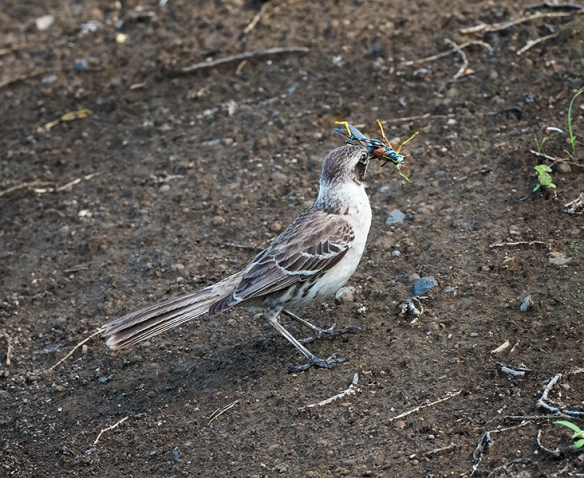
Approaching Storm at Sunset
(Techniical Stuff: Nikon D810 handheld on moving ship with 70-200mm f/2.8 lens extended to 150mm; exposure 1/250th sec. @ f/14, ISO 800; four images photomerged)
The volcanic archipelago making up the Galapagos Islands is relatively young by geological measures and on some of the newer islands you may see only the initial stages of plant life.

A Cactus Plant Finds a Spot on a Lava Formation
One of the strange aspects of volcanic activity is the formation of lava tubes. Don’t ask me for an understandable explanation, but it has to do with the lava flow cooling and becoming hard on the surface, while still-hot lava continues to move under the hardened surface. In some cases, when the eruption ends, the last of the moving lava proceeds through the channel, draining it and leaving a long cave behind.

Lava Tunnel
(Technical Stuff: Nikon D810 handheld with 24-70mm f/2.8 lens extended to 24 mm; exposure 1/25th sec. @ f/2.8, ISO 1600; two images photomerged)
The tunnel was interesting but very dark and creepy, a great location for a horror movie. And it was the wildlife we wanted to see so not a lot of time was spent there.

Two Sea Lion Pups Napping as Marine Iguana Strolls By
The Galapagos marine iguana is the only iguana that has evolved from a strictly land-based creature to one that swims and feeds in water. They are found nowhere else on the planet. They feed on ocean algae, often fully submersed, and even have a special gland common to marine birds that enables them to extract excess salt from their blood and sneeze it out several times a day.
 Sea Lion Yawning
Sea Lion Yawning
The sea lions found in the Galapagos Islands are the smallest of the sea lion species. The female gives birth to a single pup a year after mating and she stays with it for the first week after birth. She then will depart for one to four days to hunt, while other females of the colony stay behind to watch over the youngsters. Eventually, the pups join their mother to develop swimming and hunting skills.
 Galapagos Mocking Bird
Galapagos Mocking Bird
(Techniical Stuff: Nikon D810 handheld with 70-200mm f/2.8 lens extended to 200mm; exposure 1/250th sec. @ f/8, ISO 800; very tight crop of final image)
The smaller birds, such as the Galapagos mocking bird, were more timid than most of the island wildlife but they still provided photo opportunities on occasion. Interestingly, there are seven subspecies of the Galapagos mockingbird, and each one seems to be largely endemic to different islands of the archipelago. Apparently, it was the differences (such as beak size and shape) among these birds, as well as his better known study of the Galapagos finches (15 subspecies) that sparked Darwin’s thinking about adaptive evolution.
 Sunrise, Floreana Island
Sunrise, Floreana Island
Coming Next: The World Famous Blue-Footed Booby

Love the Galapagos. When I went I wasn’t into photography really. Would love to go back again. 🙂 Great photos.
LikeLiked by 1 person
Hi, Susan. Great to hear from you and thanks so much for the comments. After seeing your great work in other locales, I would love to see you return there, I know you would come back with some fabulous images.
LikeLike
I’d love love love to go too!
LikeLiked by 1 person
Warning, a few more tempations will be published in the next post;-)
LikeLike
These are fabulous photos, Robin. I have been to the Galapagos but don’t remember many of the animals and birds that you have seen !
LikeLiked by 1 person
Thanks, Annette. Very kind words and I appreciate them. I think what you see depends on which islands you visit. For example, we didn’t see the red-footed booby because it doesn’t inhabit the islands where we stopped.
LikeLike
As I said in Part 1, such an amazing place! I think it would be neat to explore the lava tubes! It’s a wonder anything can grow on the lava. And that grasshopper is almost as big as the mocking bird.
LikeLiked by 1 person
Thanks for writing, I’m glad you liked the post. Not too sure I’d want to walk very far down that lava tube, however;-)
LikeLiked by 1 person
Good mix of fauna, landscape and wildlife, Robin. Would love to sail to the Galapagos!
LikeLiked by 1 person
Thanks, Chris! That would be a wonderful way to explore them. We were on a relatively large ship on a relatively tight schedule and it was a great experience. But havbing the flexibility to meander on your own schedule would be outstanding. Plus, you would add some pretty cool species to your bird imagery.
LikeLiked by 1 person
What an interesting place … great post! Did you see any racer snakes? I recently saw a nature program about Galapagos that showed some kind of lizards hatching on the beach and hundreds of racer snakes coming out of the rocks chasing them. It made me change my mind about ever wanting to visit Galapagos!
LikeLiked by 1 person
Thanks, Denise. No, we didn’t see any snakes. Someone else told me about that film clip when we returned. Apparently, that is a characteristic of the racer snakes on one island, Fernandina. Also, that species is endemic to the Galapagos. Glad I didn’t see anything like that.
LikeLiked by 1 person
It looks an amazing trip, Robin. 🙂
LikeLike